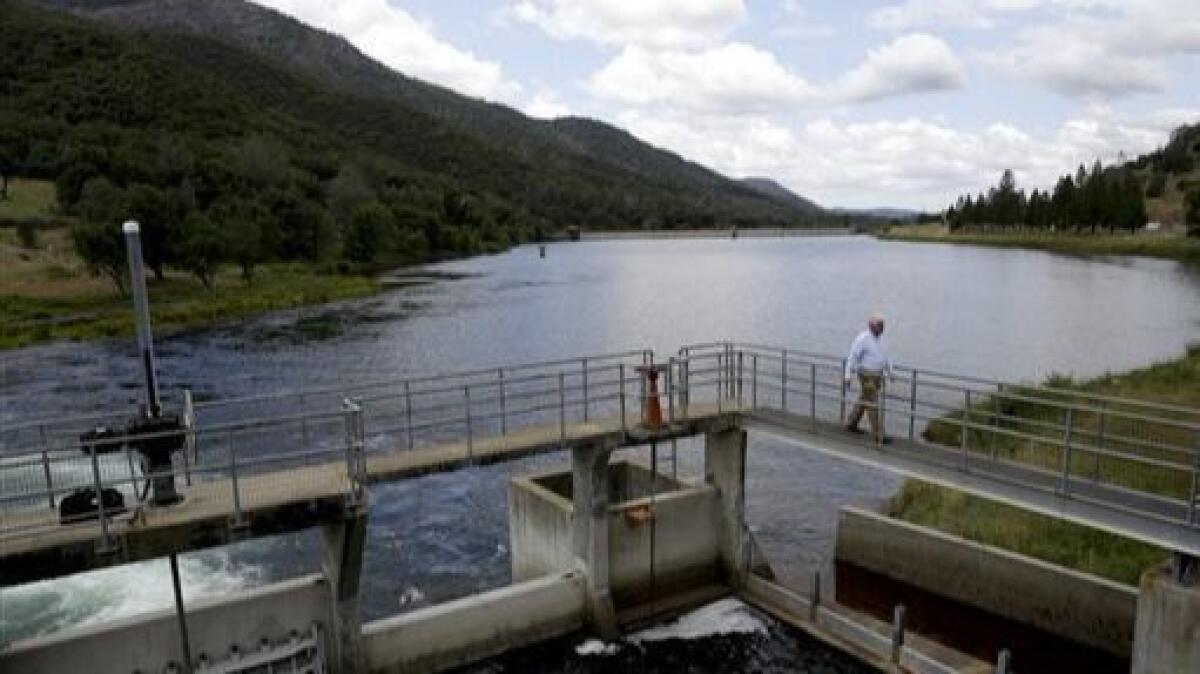State board again delays vote on contentious river plan

- Share via
Under pressure from Gov. Jerry Brown’s administration, state regulators once again postponed a vote on a contentious plan to force San Francisco and several big San Joaquin Valley irrigation districts to give up some of their water supplies for environmental protection.
On the eve of Wednesday’s scheduled vote, Brown and the man who will succeed him next year, Lt. Gov. Gavin Newsom, asked for a month’s delay and promised to get involved in ongoing settlement negotiations.
If adopted, the State Water Resources Control Board proposal to boost flows on three salmon-bearing rivers would amount to an unprecedented step to hold districts with historic water rights accountable for the environmental toll of their massive diversions.
The agricultural districts, which staked their claims to the river flows a century or more ago, have bitterly contested the proposed restrictions, calling them economically devastating and vowing to challenge them in court.
The water board staff spent years developing the proposed standards and the Brown administration has long advocated voluntary agreements to avoid a prolonged legal battle. Talks between state officials and river users picked up after the final board proposal was released in July.
The board postponed a scheduled August vote, but with no settlement on the immediate horizon, appeared ready to adopt the flow requirements on Wednesday.
At the last minute, Brown and Newsom wrote board chairman Felicia Marcus, asking for a postponement. “During this time, we pledge to actively and meaningfully engage to bring this vital matter to a successful closure,” the Democrats said.
At Wednesday’s meeting, environmental advocates argued that more delay would weaken the state’s hand in settlement negotiations.
State officials and river users, on the other hand, insisted that by December they could come up with an agreement that would meet the board’s ecological objectives.
“This is it. No more time beyond the next 35 days,” said California Fish and Wildlife Director Chuck Bonham, who represents the state in the confidential negotiations. “The Brown administration will not seek another delay.”
Marcus said she agonized over whether to again postpone the vote. But she ultimately chose to heed Brown’s call for more time.
“Reluctantly — but with hope — I will support giving it a try. I’m firmly committed to act in December,” she said.
Board members are appointed to four-year-terms by the governor, so Wednesday’s discussion played out against the coming change in administration.
The letter’s language seemed to signal that Newsom would not change course and continue to support the board in requiring greater river flows to help migrating salmon.
“It is an amazing letter,” board member Tam Doduc said, citing a paragraph in which the political leaders said any agreement would “obligate water rights holders to improve stream flows and restore habitat.”
The current board proposal would collectively cost water districts 300,000 acre-feet of supply — or roughly 15% of their total diversions on the Stanislaus, Tuolumne and Merced rivers. But the board has left the door open to relaxing those requirements if water users agree to other measures to improve fish conditions, such as expanding floodplains and restoring habitat.
San Francisco and several big irrigation districts draw so much water from the three tributaries of the San Joaquin River that their average flows range from 21% to 40% of what they would be without dams and diversions. At times the river beds hold as little as 10% of the natural flow.
Combined with pollution and habitat loss, the diversions have helped drive once abundant salmon runs to the brink of extinction and contributed to a cascade of ecological problems downstream in the Sacramento-San Joaquin Delta, the heart of California’s water system.
Twitter: @boxall
More to Read
Sign up for Essential California
The most important California stories and recommendations in your inbox every morning.
You may occasionally receive promotional content from the Los Angeles Times.














